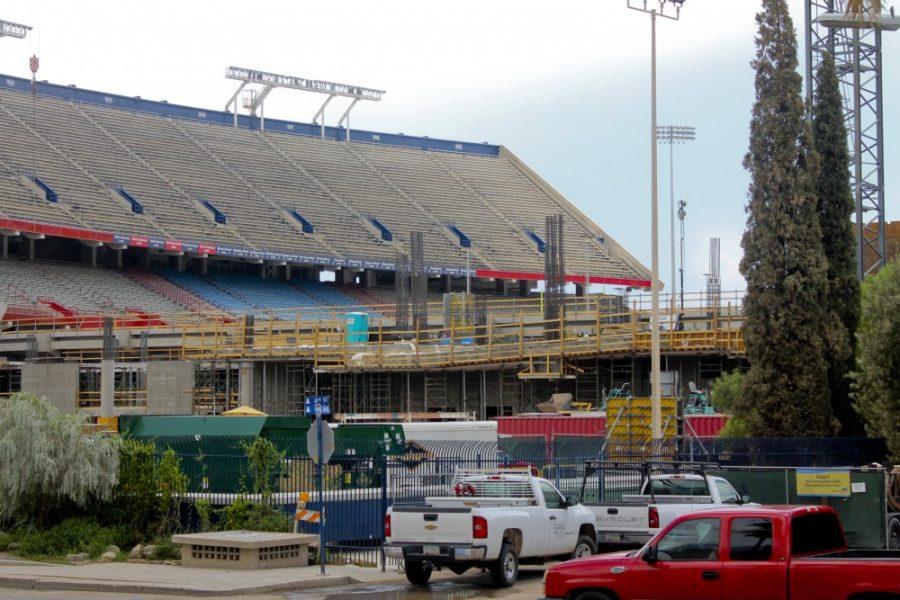“Better late than never” might as well be the motto of Arizona’s North End-Zone expansion.
The $72.3 million project, called the Lowell-Stevens Football Facility, still has a year left before its planned completion date of July 2013, but its continued progress represents a new era of football in Tucson.
“It will change the look and feel of Arizona football for a very long time,” athletic director Greg Byrne said.
The Wildcats are one of the only football programs in the country to not have its own facilities. Rather, the team shares them with the basketball team in McKale Center.
“We are probably the only BCS-level football program to have their football infrastructure … in the basketball arena,” he said. “Most schools moved out about 20 years ago, and we had not done that. So from an infrastructure standpoint, we probably had not been as efficient or as near as up-to-date as everyone we were competing against.”
New additions include a full concourse area connecting the east and west sides, chairback seats all across the lower bowl, and new club area for seating.
But Byrne said the most important element of the project is to help the experience of the student athletes.
While the lower bowl of the stadium is already finished and the project is still on schedule, the facility is about 30 percent complete. During the season, the new seats won’t even be in place and there will be a tarp over the section, Byrne said.
“But (fans) will see as the season progresses the building connected to the seating areas will continue to go north and it’ll be exciting to watch,” he said.
The stadium is still undergoing major construction throughout the year and some of the entrances to the stadium won’t be accessible, so showing up before kickoff isn’t recommended.
“(Fans) will still safely be able to get in and out of the stadium, but we need people to arrive as early as possible,” Byrne said.
He added that the gates open an hour-and-a-half before kickoff, and that they’ll provide entertainment on the video board.
Outside of the seating aspect, the facility will allow the football program to finally move out of McKale and relocate into a football headquarters complete with new locker rooms, weight rooms, meeting rooms, coaches offices and a full cafeteria that will be available to the general public.
“The impact on our student athletes has to be the top priority,” Byrne said, “but we’re also very glad that during that time we can positively impact our fans.”
The building isn’t only designed to help the players currently on campus — it’s also meant to bring more talent to the university, both in terms of student athletes and coaches.
Byrne said he brought up the project within the first 10 minutes of his recruiting pitch to the new football head coach Rich Rodriguez.
And Rodriguez is following suit, as he said the expansion is often one of his first talking points when talking to recruits.
“(The expansion shows) that ‘hey, we are serious about our program and we’re reinvesting in football and we’re building for the future,’” Rodriguez said. “And that part has got me as excited as anything.”
The next step will be to address the east and west sides of 85-year-old Arizona Stadium and improve the fans’ amenities — specifically the bathrooms, concourse areas and entrances and exits, Byrne said.
But he cautioned that, from an expense standpoint, the university is already spending a little more than $72 million on single part of the stadium.
“So to address the rest of (the stadium), it will be very expensive for us in what we need to do,” he added. “But we have to find the resources and the plans to do that because it’s a (85) year old facility.”
The expenses for the Lowell-Stevens Football Facility initially came from donors, including the two families it’s named after, J. David and Edith Lowell and Jeff and Sharon Stevens.
Together, they donated a combined $23 million to the project, which added to the approximately $35 million in donations and pledges Arizona received.
But the rest of the funding will come through a debt service plan which will target the increased revenue from the added club seating. Some of the money from the new Pac 12 Network could also be used as a fall back.
Flowers looking forward to facility despite short stay
Count junior safety Marquis Flowers as a proponent of the new facility, even if he will only be around for its inaugural season.
“I think it’s a huge step,” Flowers said. “It shows this town really cares about football, this school really cares about football. Now it’s on us to win football games. We have all the stuff we need and (we’re) getting stuff we need, which is pulling in recruits. It’s looking good for us right now.”
Even though Flowers will only have his senior season to experience the facility, he is still excited to come back and see it after he graduates.
And once it’s complete, Flowers is going to take full advantage of the new building.
“If it’s that nice, like I know it’s going to be, I’ll be back (after graduation),” Flowers said. “Coach Rich (Rodriguez) can’t get rid of me that fast.”















